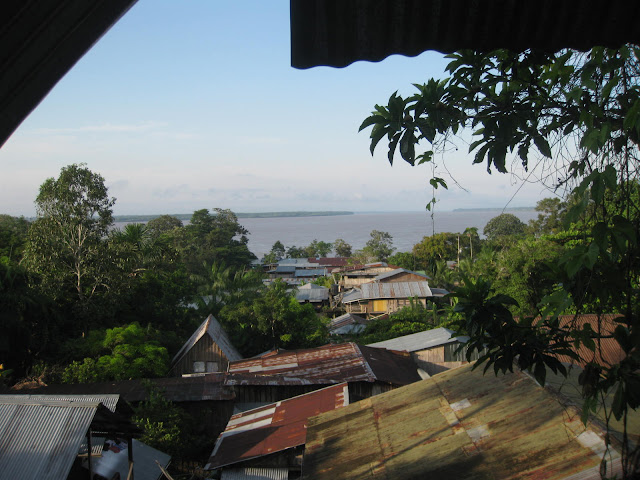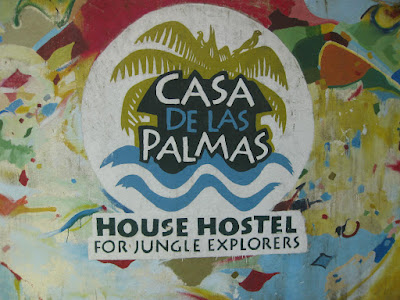 |
| A painted-up tuk-tuk -- the colorful way to taxi around in Leticia. |
An hour or so by air out of Medellin, I knew that we were in for it. Off before us in the dusk, towering spirals of clouds had ascended from the endless mat of green far below. Arcs of lightning flashed from spiral to spiral or crashed to ground in fantastic light displays. Turbulence rocked the airplane as we descended.
After landing at Leticia, we disembarked onto the tarmac and walked out through a deluge. Within seconds clothes and luggage were soaked. Two men in sage uniforms awaited inside with a smiley dog who sniffed at our luggage. Shiny leather boots rose up to their knees and stirrups protruded from their heels. Two horses were tied up a short distance off. It was the last thing that I expected to see there -- a horse patrol at the airport.
Thus was my arrival in Leticia, Colombia, a town along the mighty Amazon River, where the rainy season was picking up intensity and the river rising.
 |
| Center-city Leticia. |
Leticia -- the town of tres fronteras, as it's known -- the three frontiers or three borders, where three countries come together. You can stroll a few blocks into Brazil for breakfast, go back into Colombia for lunch and take a launch across the river into Peru for dinner -- all without too much effort.
And not to worry about pesky things like entrance visas or getting passports stamped -- it's open borders in all directions. No impediments whatsoever, except for the terrain. (If you proceed farther on into any of these countries, however, you must go through customs.)
Many businesses accept payments in two or even three different currencies and some take U.S. dollars. So despite the relative isolation, the feeling of being on an urban island within a sea of jungle, the place emanates an international air.
Once you get outside of town, no roads exist for hundreds of miles -- only waterways, wetlands and green vegetation that goes on and on. A few flights like mine come in daily, but otherwise all transport and commerce are by river. In fact, at the center of everything here, it seems, is the river.
 |
| The Amazon near Leticia. A mile-and-a-half across. |
 |
| Passengers and freight coming in from downriver in Brazil. |
,
 |
Accessing some of the boat docks can be a little tricky.
|
If you're coming in from North America, Leticia is your most direct routing to the Amazon basin. You'll have to change planes in Colombia first, in Medellin or in Bogota, then two or three hours on by air from there.
In my case, I spent a week in the city of Medellin, one of my favorite places. In this manner I got acclimated to South America again and being deposited into those steaming conditions later on was not so much of a shock. Believe me, compared to the 0 degrees when I boarded the plane in NYC Jan. 16, the heat and humidity of the Amazon were indeed a shock.
After a few days in Leticia, however, I was over it. The inhabitants were a big reason. Almost everyone I passed there smiled, said buenos dias or bobbed their heads in recognition. In addition, the town is easily transited by foot and has its own culture, food and sights, all tinged with that unique Amazonas influence.
 |
| The fillet of fish on a banana leaf here is a must. |
 |
| Roast porker at Santander Park on Sundays. |
 |
| Jaguar statues within a traffic circle. |
-
Of the things to do, I especially enjoyed going to the harbor and watching the activities, the boats being loaded and unloaded, and so on. Also the daily doings at the tribal mercado or market place, the gathering of thousands of chirping parakeets every evening at Santander Park, and more.
All in all, Leticia is a lively place to visit and during my stay there I was never bored.
 |
| Along the harbor front in Leticia. Umbrellas protect from the sun and the rain. |
 |
| Even an outlet there for the gamblers. |
After a few days though, it was time to expand out from the town. The hostel where I was staying was organizing a tour and I was invited to join in. The trappings of civilization, however rudimentary, were about to be left behind as we motor-boated, and then hiked, deep into the rain forest.
 |
| My base for touring the area. |
Part II To Follow Next Weekend






























